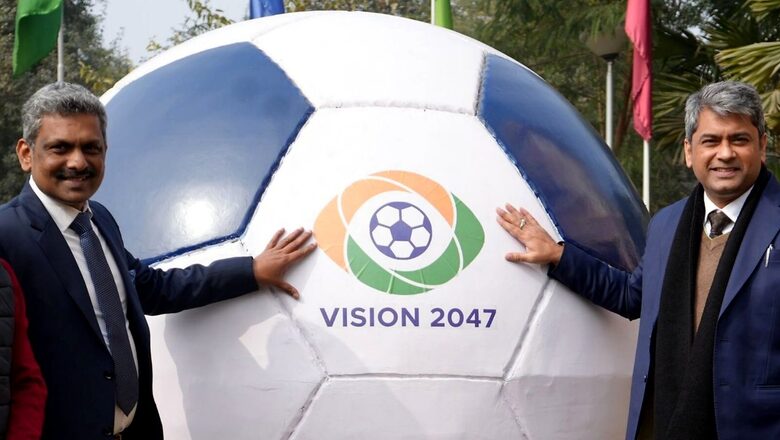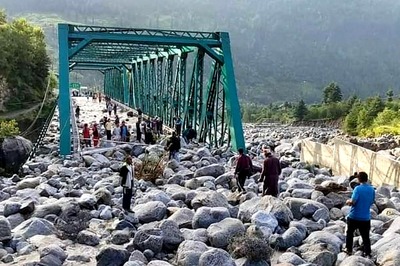
views
All India Football Federation (AIFF) president Kalyan Chaubey and secretary general Shaji Prabhakaran revealed the roadmap for the future of India’s football. The governing body unveiled a big roadmap and named it ‘Vision 2047’ as it hopes to take India to big heights in the centenary year of country’s independence.
From developing the talent pool to the economics of revenue Chaubey and Prabhakaran talked about the various aspects which will be the key for Indian football’s growth but the thing which stood out was the mention of Arsene Wenger.
The AIFF president revealed that the former Arsenal manager and world governing body FIFA’s current chief of global football development is going to play a role in Indian football’s grassroots programmes and talent development.
Chaubey met Wenger during the FIFA World Cup last year in Doha where talked with him and other senior officials of the FIFA and Asian Football Confederation (AFC) regarding youth development projects in India.
“We have had extensive discussions with FIFA development team. Arsene Wenger is head of FIFA Task Force and they will help us in grassroots programme. Coaches from Wenger’s team would come,” Chaubey said after unveiling its ‘Vision 2047’ roadmap.
“About football budget cut, we have got lot of help from government and ministry and we have never been turned down when we requested for something. In future too, we will expect whatever we deserve in terms of help, government will give us,” he added.
Developed in conjunction with all stakeholders of Indian football, the roadmap has also sought and incorporated inputs from the AFC and FIFA. The salient ambitions of the roadmap are to see India among the top four footballing nations in Asia, host one of the top leagues in the continent, and create a vibrant footballing ecosystem.
The governing body has made some targets which they want to achieve by 2026 and the longer plan is to make India a powerhouse in Asian football in their vision for 2047.
“‘Vision 2047’ has been broken down, for diligent implementation, into six four-year strategic plans. The first of these will look to cover the period till 2026.
“With a shared vision and by sharing responsibility, we can implement targeted programmes to address key areas identified in this roadmap and help build capacity for the football ecosystem,” Chaubey said.
He said the aim is to revive “the glory days of Indian football as it was in the 1950s and 60s and becoming a powerhouse of Asian football once again”.
One of the key aspects of the roadmap is to ensure increased access to competition and games for players plying their trade in the country. federation wants to ensure players will be able to play at least 55 matches across different competitions every season.
“Transformation will begin at home through a reform of the organisational culture,” secretary general Shaji Prabhakaran said, referring to a need for better governance of the game across the country.
“A restructuring exercise will be carried out to streamline current operations and develop a team which adopts the industry’s best practices and is transparent in its dealings.” “centenary of the federation,” Prabhakaran said, “India will be among the top seven countries in Asia, and a strong contender to qualify for the World Cup on merit.” The federation recognises that growth in modern sport requires a business outlook. The federation will dedicate an entire division — business and marketing — to develop, cultivate and invite investment and partnerships in Indian football.
The AIFF President stated that the members of the organisation travelled to various parts of India including the North-East states – Tripura and Nagaland to scout the young talent.
The federation observed that at the grassroots, the game has low participation relative to its size and population. There is a huge gender disparity in participation, and a lack of facilities and playfields in urban areas where children can come out and play.
A lack of cohesion and focus between different stakeholders has led to significant gaps in funding.
The Federation observed that the talent development ecosystem is currently informal, with clubs and Federation bodies all largely working in silos without a systematic or uniform approach. The AIFF proposes to change this by creating a data driven scouting structure from the Elite Youth League System for its National Teams. Clubs will drive talent identification at grassroots unto the Elite Youth structure.
The AIFF’s 2026 target is to reach 35 million children through grassroots programmes and implement village grassroot programmes across 100 villages throughout India. The flagship grassroots project will also aim to register 1 million registered players and provide football education to 25 million children through Football for Schools.
The federation recognised that while women’s football has been growing rapidly across the world, it has previously received very little attention in India. The weak ecosystem needs specific solutions to help increase participation and competency across the pyramid.
Some of the proposed solutions include better adoption of women’s football by clubs across different levels, incentivising the role of coaches, referees and match commissioners for women, as well as providing a minimum salary to women’s players.
The period of the first strategic plan — the federation will ensure the creation of a four-level league table pyramid, the top of which will be occupied by the Indian Women’s League (featuring 10 teams), followed by the 2nd Division (8 teams).
In addition, there will be five zonal leagues with eight teams each. A new women’s youth league structure has been proposed, which will see players across different age groups play a minimum of 14 matches.
The federation will ensure that a minimum of 20 states implement the new women’s youth structures by 2027.
On the men’s side, the current strategic plan will ensure the creation of a three-tier national league pyramid with 40 teams. The Indian Super League and I-League will boast of 14 teams each while the I-League 2nd Division will consist of 12 teams.
A state championship structure will see city and district leagues feed into the state championships. A revamped men’s youth league structure will see the local state youth league and elite youth leagues will run simultaneously.
Clubs and academies will participate in both with the winners of the state youth leagues qualifying for the Elite youth league.
One of the cornerstones of the roadmap is the “creation of a national playing philosophy, which will be developed over time after consultation, observation and exploration”.
(With Agency Inputs)




















Comments
0 comment